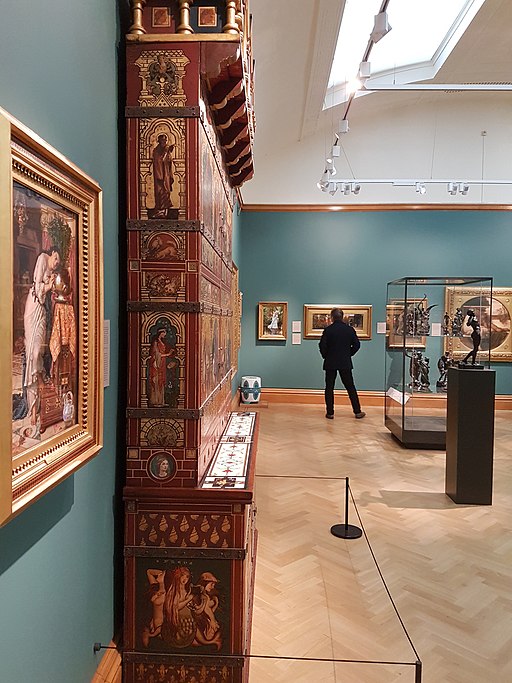
The Great Bookcase is an elaborate and highly decorated example of Victorian Gothic painted furniture. The Pre-Raphaelite paintings on the bookcase depict Pagan and Christian art expressed in allegories of poetry, music, architecture, sculpture, and painting.
Work on the Bookcase began in 1859 and was completed by 1862. The bookcase design was based on surviving medieval furniture. However, the bookcase decorations are 19th-century artwork.
William Burges (1827–81), the eminent Victorian architect and designer who orchestrated the deign, believed that, in addition to serving a practical purpose, furniture should also tell a story. The bookcase was designed by William Burges to hold his collection of art books,
The Great Bookcase is significant for its painted scenes and decoration. Christian themes are painted on the left side of the bookcase, and Pagan themes on the right.
It was decorated by fourteen Pre-Raphaelite and Victorian artists, which included:
- Edward Burne-Jones
- Henry Holiday
- Dante Gabriel Rossetti

The Christian decorations include:
- St. John and the New Jerusalem
- The apparition of Beatrice to Dante
- Edward I and Torrel
- Fra Angelico painting the Virgin
The Pagan decorations include:
- Rhodopis commissioning a pyramid
- Sappho serenading Phaon
- Apelles painting the first portrait
- Pygmalion and Galatea
The base of the bookcase features four metamorphosic figures, in the form of Arachne, the Pierides, and Syrinx.

Above the front panels is a cornice decorated with muses, and surmounting the cornice are three painted gables. The three gables feature painted depictions of ‘Religion’ ‘Art’ and ‘Love.’
On the sides of the bookcase are depicted:
- Saint Augustine
- Plato by Rossiter
- Saint Cecilia
- Orpheus
- Sirens
- Harpies
The bookcase is 10 feet (3.0 m) high and 5 feet (1.5 m) wide, and the interior of the bookcase is also decorated with birds.
In 1933, the bookcase was purchased for the Ashmolean Museum by Kenneth Clark, Clark paying £50.
William Burges
William Burges ARA (1827 – 1881) was an English architect and designer. Among the greatest of the Victorian art-architects, he sought in his work to re-establish the values of a utopian medieval England.
Burges was part of the Gothic Revival movement; his works echoed the Pre-Raphaelites and pointed to the Arts and Crafts movement.
Beyond architecture, Burges designed metalwork, sculpture, jewelry, furniture, and stained glass. The revival of interest in Victorian art, architecture, and design in the later twentieth century led to a renewed appreciation of Burges and his work.
Great Bookcase
- Artifact: Great Bookcase
- Date: 1859-62
- Material: Oak, carved, painted, and gilt
- Made: London, England
- Dimensions: H 317.5 cm (125 in); W 173.9 cm (68.5 in); D 49.5 cm (19.5 in)
- Style: High Victorian Gothic, Pre-Raphaelite
- Museum: Ashmolean Museum of Art and Archaeology
William Burges
- Artist: William Burges
- Born: 1827
- Died: 1881 (aged 53), London, England
- Occupation: Architect
Great Bookcase
Archaeology at the Ashmolean Museum
- The Alfred Jewel
- The Messiah Stradivarius
- Arab ceremonial dress owned by Lawrence of Arabia
- Narmer Macehead – Ceremonial Weapon of Ancient Egypt
- The Macehead of King Scorpion
- Sumerian King List
- The Battlefield Palette 3100 BC
- Princess Fresco
Art at the Ashmolean Museum
- “The First Anniversary of the Death of Beatrice” by Dante Gabriel Rossetti
- “Holy Family with St John the Baptist” by Michelangelo
- “A Converted British Family Sheltering a Christian Missionary from the Persecution of the Druids” by William Holman Hunt
- Chalk sketch of “The Day Dream” by Dante Gabriel RossettiGreat Bookcase
Amazing Art and Artefacts from the Ashmolean Museum
A Virtual Tour of Museums in London
- The British Museum
- The National Gallery, London
- Tate Britain
- The Wallace Collection
- The Victoria and Albert Museum
- Queen’s Gallery, Buckingham Palace
- Courtauld Gallery
- Tate Modern, London
- Science Museum, London
- National Portrait Gallery, London
- Natural History Museum
- Charles Dickens Museum
- Hampton Court Palace
- Sherlock Holmes Museum
- British Library
- Imperial War Museum
~~~
“The saddest thing about any man is that he be ignorant, and the most exciting thing is that he knows.”
– Alfred the Great
~~~
Photo Credit: Gts-tg / CC BY-SA (creativecommons.org/licenses/by-sa/4.0)
Popular this Week








 Sponsor your Favorite Page
Sponsor your Favorite Page SEARCH Search for: Search Follow UsJoin – The JOM Membership Program
Sponsor a Masterpiece with YOUR NAME CHOICE for $5
Share this:
- Tweet
